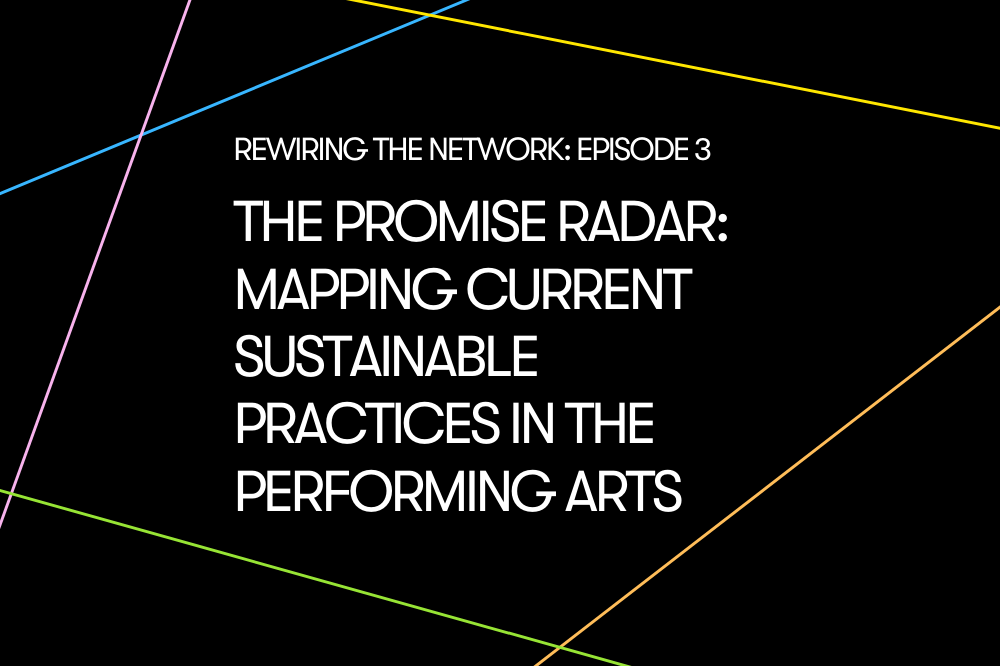Rewiring the Network - Episode 3: The Promise Radar: Mapping current sustainable practices in the performing arts
This fourth episode of the Rewiring the network for the twenties series evaluates the results of our most recent survey and the promising aspects of our current practices.

This text has been co-authored by Martina Fraioli and is part of a four blog posts series. You can read episode 0, episode 1, and episode 2 here.
IETM was just preparing ‘Rewiring the network for the twenties’, an interactive trajectory to collectively design a more sustainable future for the performing arts, when the face of the world changed in a matter of just a couple of weeks. In the first episode of our series of blog posts, we introduced five ‘promises and pressures’ of international networking, by revisiting the 40 year history of IETM. In a second episode, we presented the first results of a survey among the membership. On a Pressures Radar, we mapped current and recurring practices in the performing arts today, which we feel cannot be sustained. Whereas the Pressures Radar painted a somewhat bleak image, we will now present a more hopeful perspective: what new, alternative approaches and examples do we see today that give us a first glimpse of a more sustainable future for the performing arts? Welcome to the Promises Radar.
A survey among the membership
As we explained in the previous blog post, we have been collecting examples of current sustainable and unsustainable practices via a short survey, sent out to IETM members in February 2020. The survey contained just two questions which were meant to help us better understand the challenges our members face with their daily work and get their views on what sustainable or unsustainable practices these days consist of.
IETM members could optionally give one or two answers to the following questions:
- Describe a typical situation, practice or habit… in the performing arts, that you were recently confronted with or took part in, which you would call “unsustainable”.
- Which example(s) of a new and alternative approach (a project, a practice, an organisation, a collaboration…) recently gave you the impression that you saw a glimpse of a more sustainable future for the performing arts?
You might know by now that we are going to use the answers to these questions as the working material in a large online brainstorm, on the 19th of May 2020, to collectively design our preferred future transitions for the performing arts. To prepare that, we have been publishing the results of the survey online. For this, we are using our infamous Rewiring Board: the interactive online whiteboard where we are and will be gathering the material from the survey and which we will continue to use as our online brainstorming platform.

So, last week we published the Pressures Radar here, mapping all the examples of current and recurrent unsustainable practices. Feel free to browse the results of the survey, to leave comments or emojis and add your own examples by adding additional pink sticky notes wherever you see fit.
Introducing The Promises Radar
So, today we move on to discuss the more hopeful side of the coin. On the Pressures Radar, we see a lot of examples of current situations which we feel we cannot sustain. On the other hand, today we also see a number of alternative approaches, experiments or innovative working models, that address dominant unsustainable practices. They might be marginal, they might not be very visible. They might be experimental and the outcome or success might be uncertain. But they are promising, in the sense that they might be a starting point for desired future developments. And if the experiments fail, we will have learned a lot.
In the survey, we asked you for examples of these experiments or alternative approaches. We received 102 examples. Parallel to the Pressures Radar, we mapped them on a Promises Radar. In fact, the Promises Radar looks quite similar to the Pressures one.
Also here, we designed a diagram that first distinguishes between an internal and an external perspective. These are the two large grey circles on the Promises Radar.
- Internal = alternative models and experiments within the performing arts field that add to the sustainability of the performing arts system.
- External perspective = either alternative models and experiments from within the performing arts that contribute to increase the sustainability of the whole society (inside out), or alternative external policies having a positive impact on the sustainable organisation of the performing arts sector (outside in).
Second, also here, we distinguished between 5 value frameworks: the artistic, the human, social, the economic and the ecological value of the arts.
|
Building further on our ‘Reframing the International’ study, these 5 values can be regarded as the ultimate promises of our work to society:
|
So, what did come out of the survey? On the Pressures Radar, we got the idea that the current conditions in which we work are hindering us to achieve these values. On the Promises Radar, we see that there are a lot of experiments and alternatives being developed in the same zones, in order to address these issues.
Once more, we kindly invite you to explore the answers on the whiteboard yourself, leave a reaction via the comment function, as explained in the how-to frame on the whiteboard itself. But let us guide you through the material. What are these experiments all about? What do they want to achieve, and who is involved?
Current promising practices in the performing arts
Concerning the economic value
On our Pressures Radar, there was a lot of input concerning economic pressures from the outside: issues with unsustainable funding models, with a.o. a lack of support for the independent scene and small-scale initiatives, lack of support for touring, issues with funding applications and - an overarching issue - a focus on ad hoc projects and a lack of long term perspectives. On the Promises Radar, we see a number of policy frameworks that address these issues:
- funding mechanisms that give a lot of autonomy to artists to strengthen them in their position with venues,
- systems that support with a long term perspective rather than one-offs,
- a situation where the local, regional and national government level actually work together in a concerted way to support artists.
It’s all out there.
Concerning the economic relationships within the arts field, there was a lot of input on the Pressures Radar concerning the socio-economic position of artists and arts workers. We see some experiments with fair remuneration schemes and interesting cooperative models. But there should be more... What examples do you know of? Add them on the Promises Radar, using one of the empty sticky notes.
Concerning the artistic value
On the Pressures Radar, we have seen a number of current practices that put a lot of pressure on the intrinsic and artistic value of working in the performing arts. For instance, the economic instrumentalisation of the arts, increasing political pressure and a lack of recognition. Also, there are a lot of internal issues. For instance, the competition within the arts field. Market mechanisms are internalised, when exchanges are not seen as collaboration or cooperation, but treated as trade of artistic products or services… The way the work is being organised in the performing arts field is often not creating the right conditions for developing the artistic value.
How to respond to these pressures and enhance the artistic quality - and the recognition of this value in society? Strikingly, we did not receive a lot of good practice examples of lobbying initiatives. Rather, there were a lot of suggestions on how we should and can put the artistic value of our work back in its central position. Basically, the answer is this: in all our collaborations, we should start from our shared ethics and value framework. We should stay true to that and practice what we preach. The result: sincere and valuable collaborations, long -term collaborations, with partners from within and outside of the arts field. These ethics can be made explicit, in good and transparent arrangements between partners and in frameworks such as a Fair Practice Code.
Concerning the social value
Concerning the social promises, we see a number of examples and experimental practices that aim at fostering community engagement. Some of these are about co-creation projects or inclusive audience development initiatives, for instance, aiming at young and new audiences. Others develop a more structural and long-term approach to cultural democracy. Basically, the idea here is not only to start from your own ideas and conceptions, but to listen to the ideas and values living in broader communities.
There are some examples of policy frameworks promoting the social value of the arts, without instrumentalising them. Someone mentioned the Create Inclusion Fund by Creative Scotland, as an example. There are also some examples of artist initiatives raising awareness about the social value of the arts, for instance via activism, ecosystems mapping or by actively contributing as artists in city development programmes.
Concerning the human value
Unfortunately, we received not that many examples of alternative models strengthening wellbeing and the human fundament within the arts. There were quite some examples of inclusive (training) programmes, an initiative aimed at creating a better work-life balance or examples of shared decision making. Still, there should be more and you might know some of these examples. Add them to the Rewiring Board by using some of the empty sticky notes.
Concerning the ecological value
Not surprisingly, here is a lot of worry and concern about unsustainable practices in the arts, which have a negative impact on our natural resources: the international performing arts are quite actively contributing to the climate crisis, because of the way the system is organised: production, presentation, touring, networking…
There are quite a lot of experiments to deal with this: setting up tours in a different and more sustainable way, a more circular approach to materials and energy when producing and presenting… More fundamentally, there is the insight that unsustainable practices are personal and have to do with ingrained habits. It is important to raise awareness and make a click, in order to change these habits, and fly less and consider other options.
Sometimes, a little pressure or some constraints from the outside can help to break down our unsustainable behaviour. We also see that there already are quite a number of experimental policy approaches to promote ecological sustainability within the arts field: for instance, Pro Helvetia stopped supporting short tours outside of Europe and the Dutch Performing Arts Fund gives additional support for those touring by train.
And, yes, someone already voiced the hope that the positive side-effect of the disastrous new coronavirus might be that it breaks down unsustainable international mobility...
Stay tuned for the online brainstorm
In the first episode of our blog series, we looked back on the past: the 40 year history of IETM, on why we started networking in the first place. We talked about the successes of international networking in the past, but also how major shifts in society and in the performing arts put pressures on the system.
In the next two episodes, we mapped the present situation. We published and summarised the results of our survey, where we asked IETM members only about pressures and current unsustainable practices, but also about new and alternative approaches (a project, a practice, an organisation, a collaboration…) which gave the impression that you saw a glimpse of a more sustainable future for the performing arts.
On the 19th of May, we will be having a large-scale online brainstorm. In this, we will be designing our preferred future for the performing arts: what would a future performing arts system look like…? Members are kindly invited to register via this link. Others will be able to follow the activity and the results via our continuing blog series.
Stay tuned!

